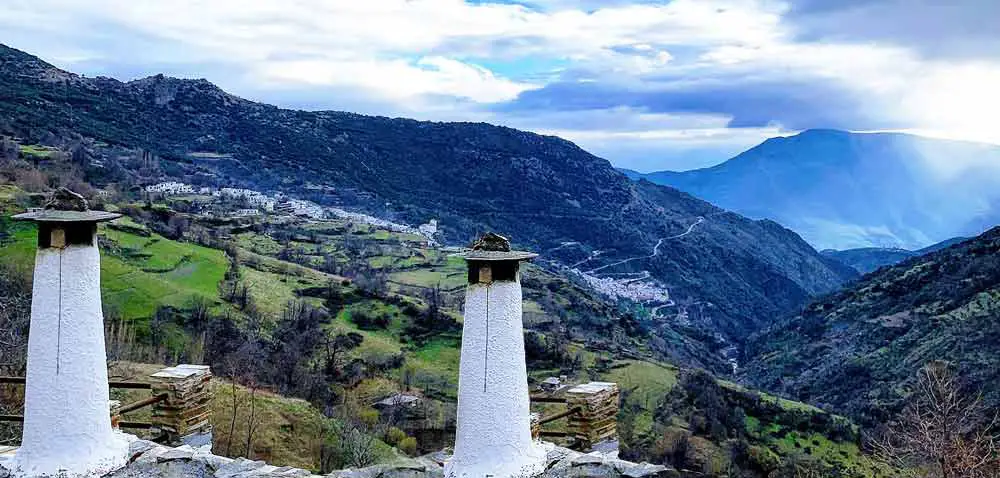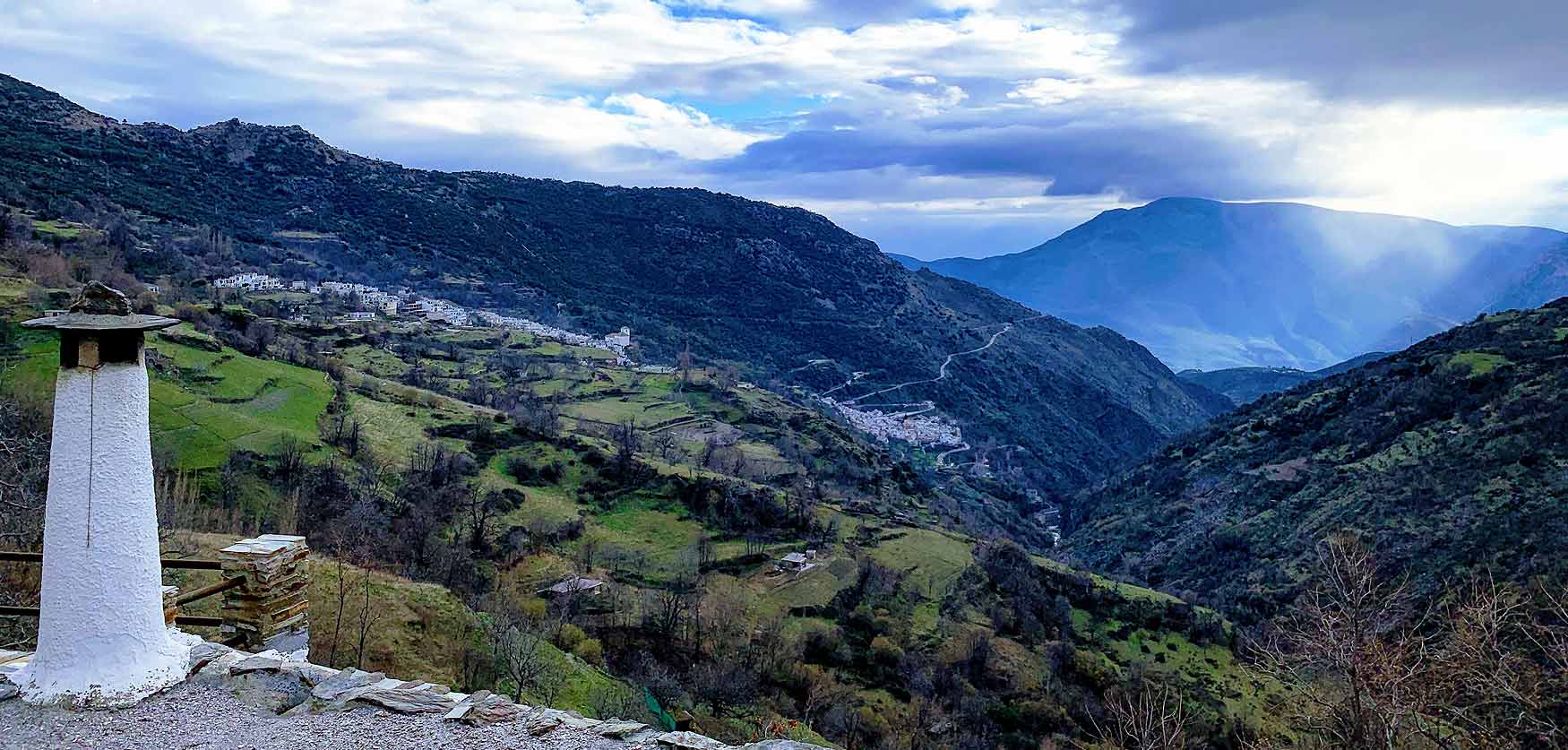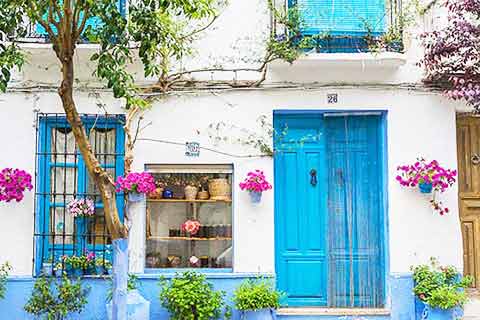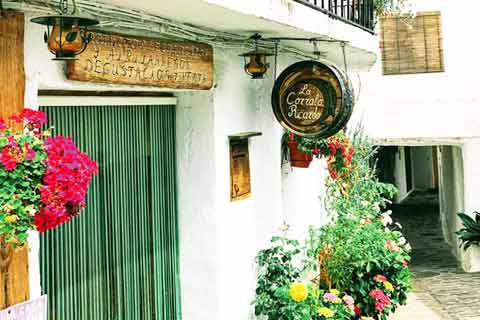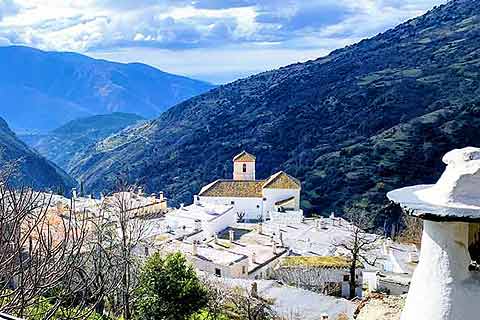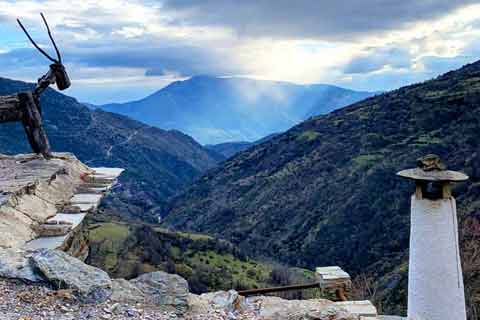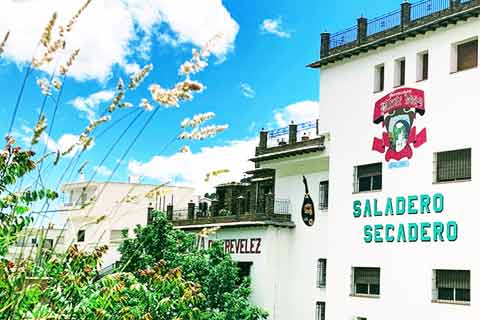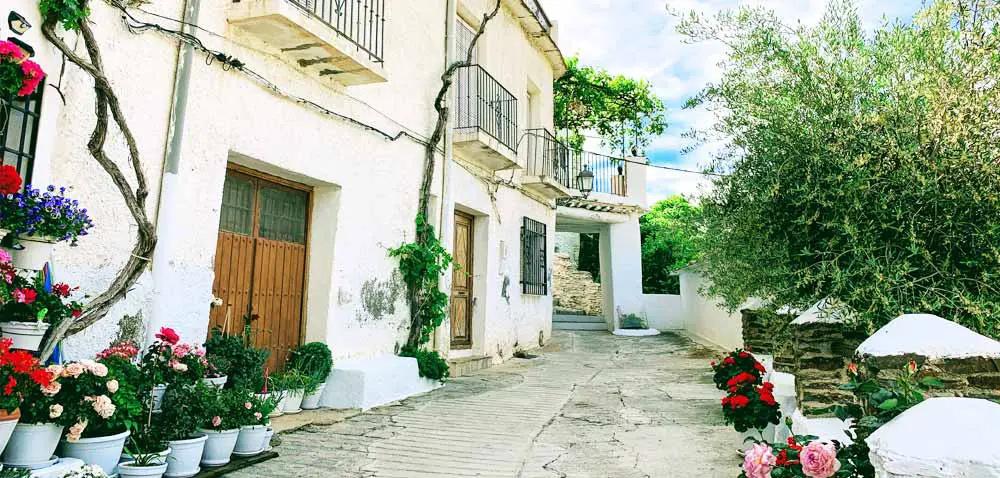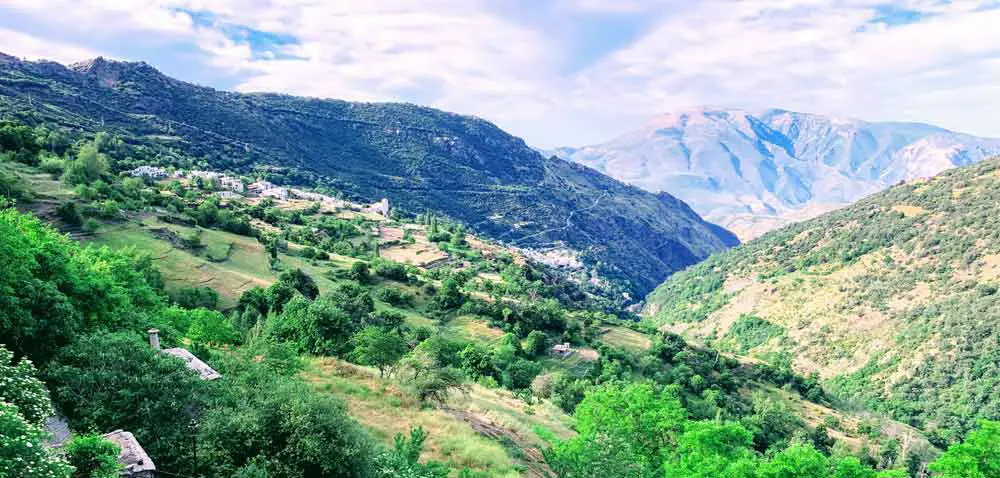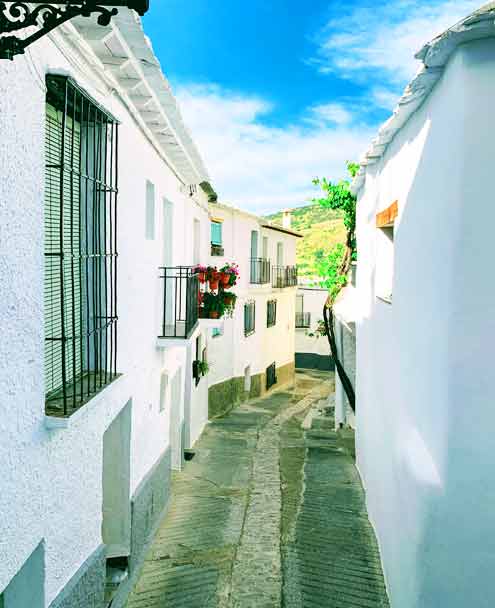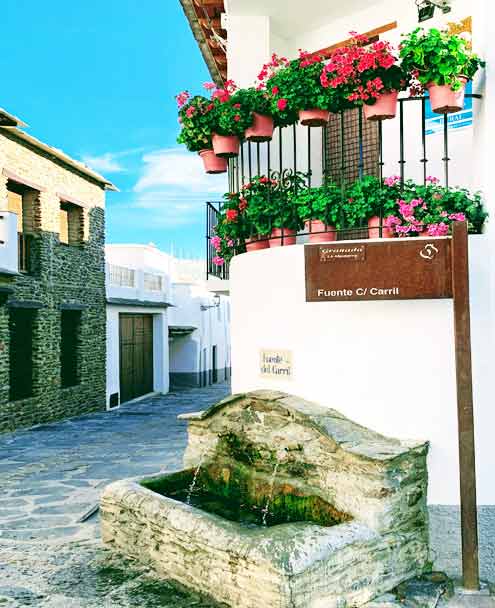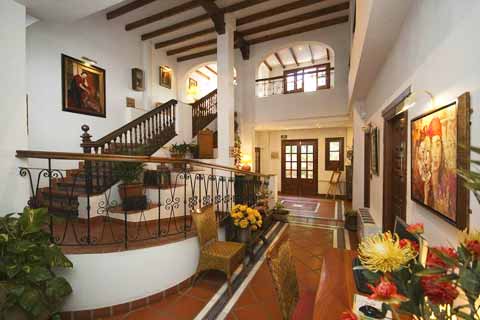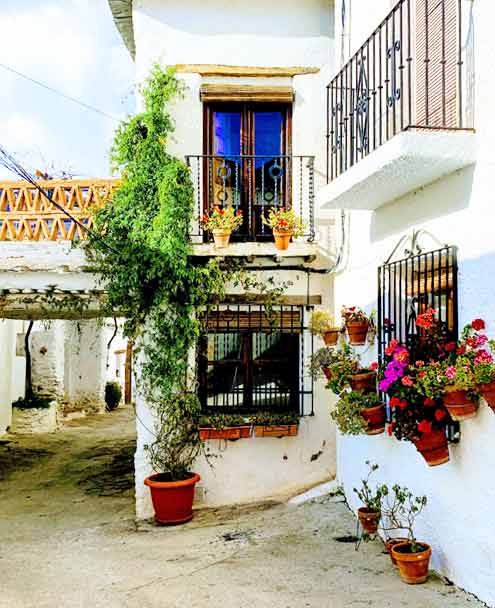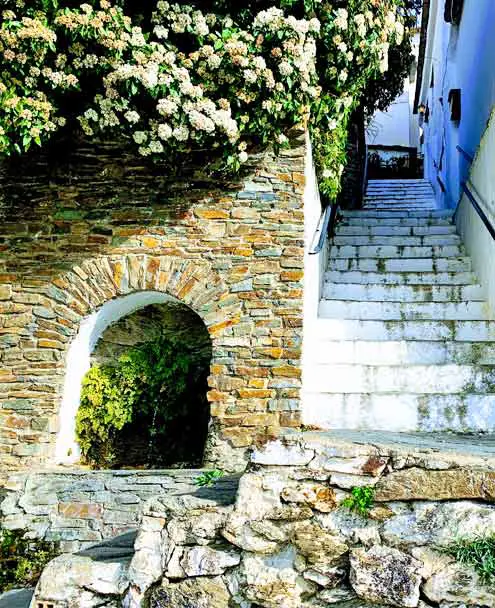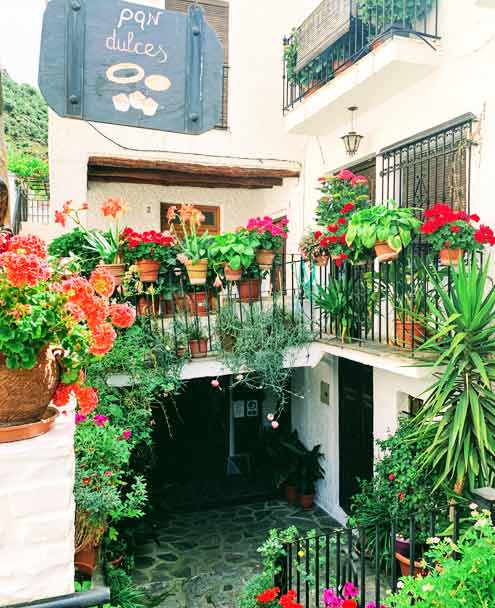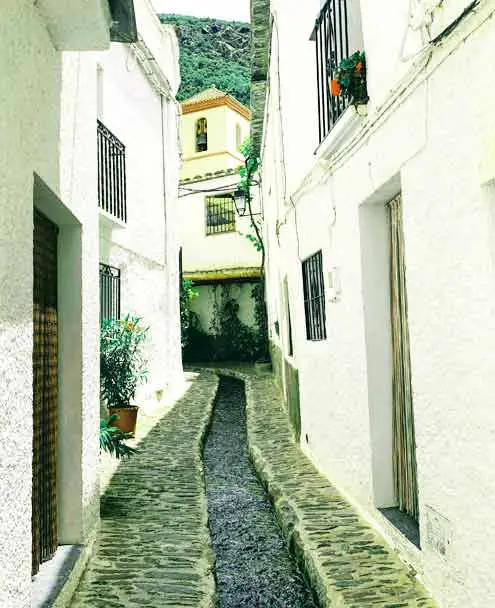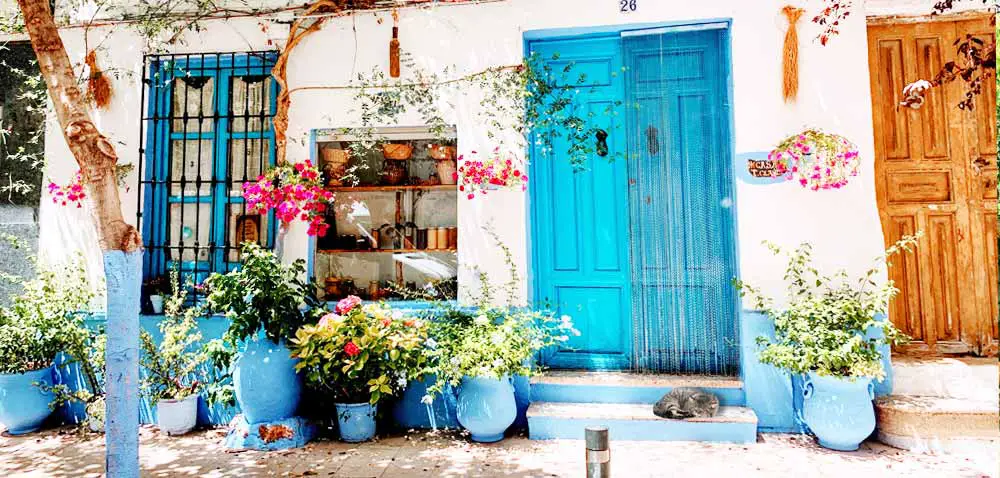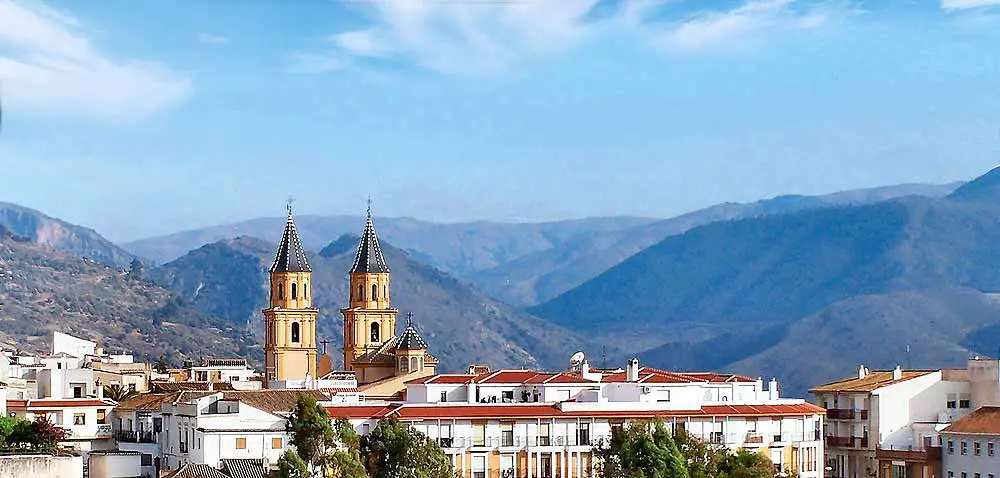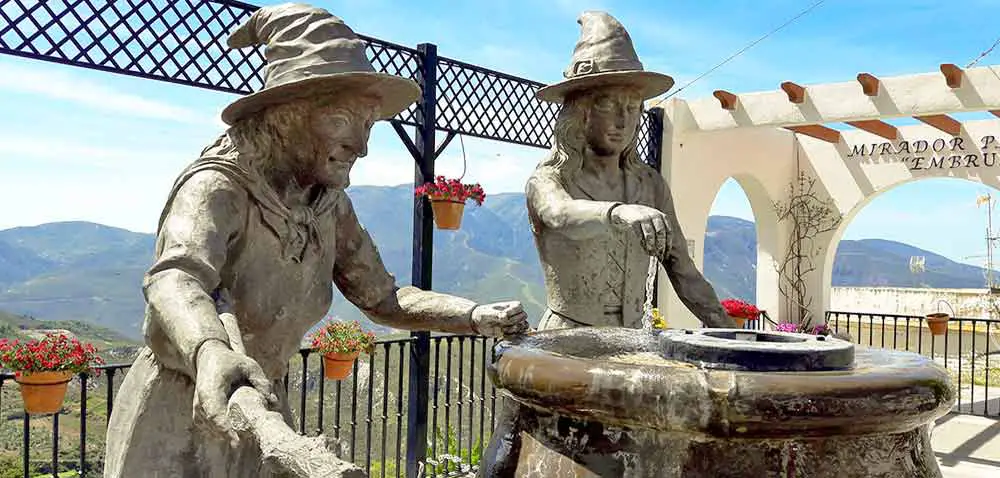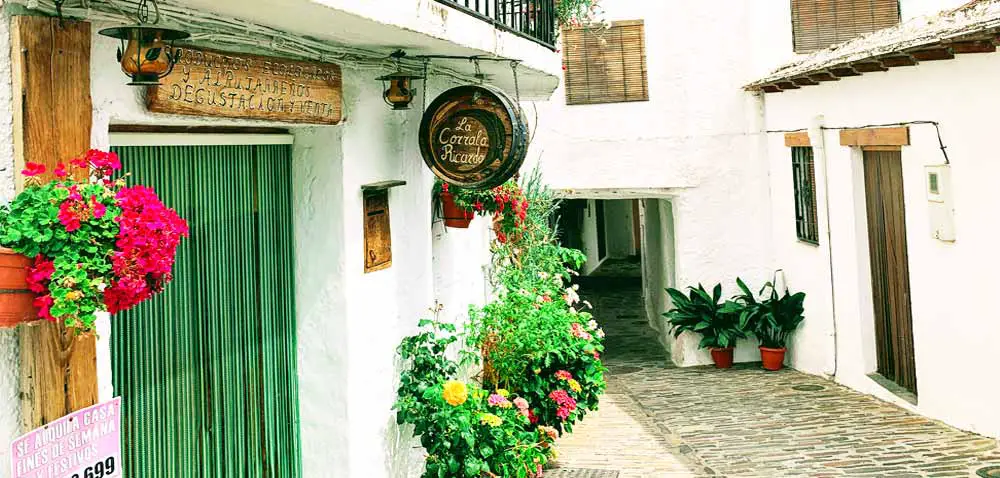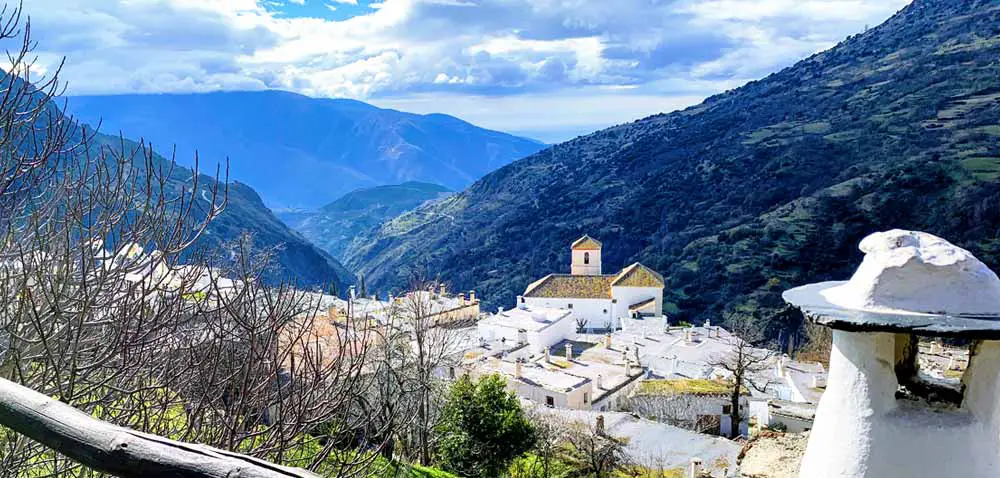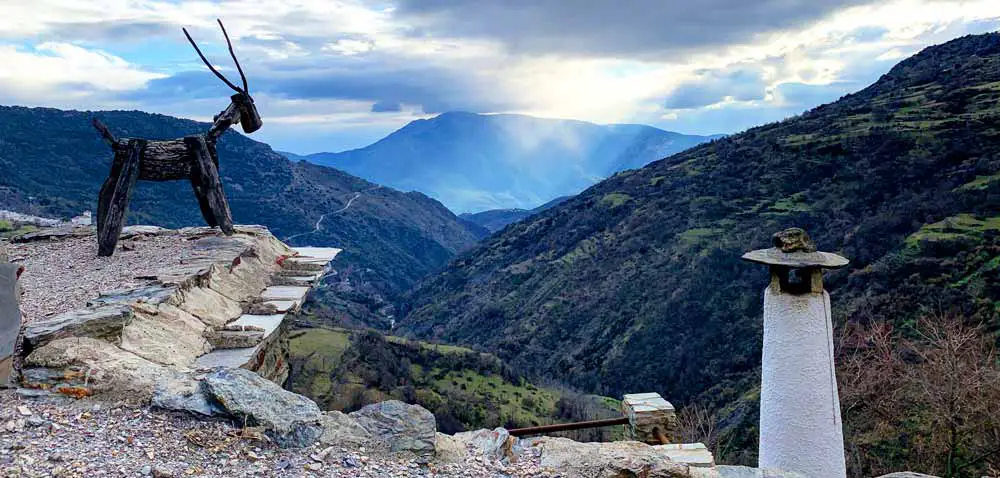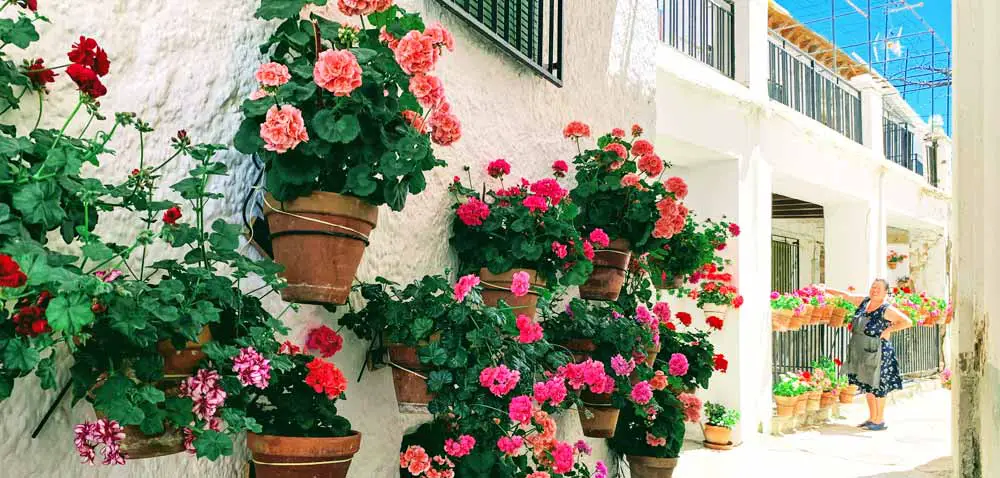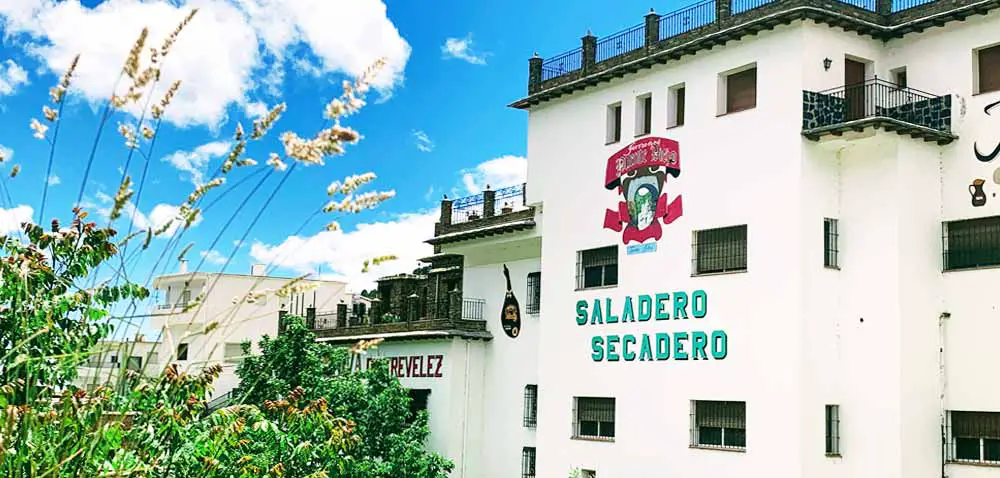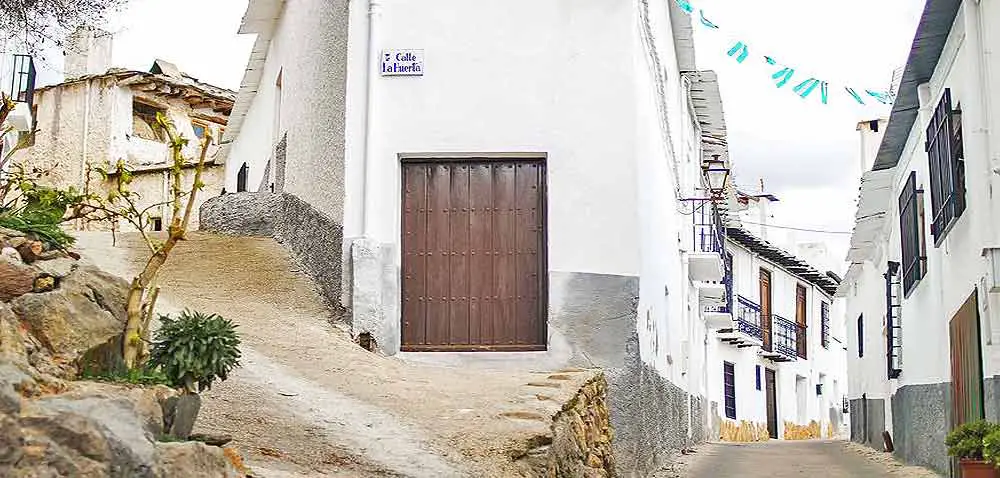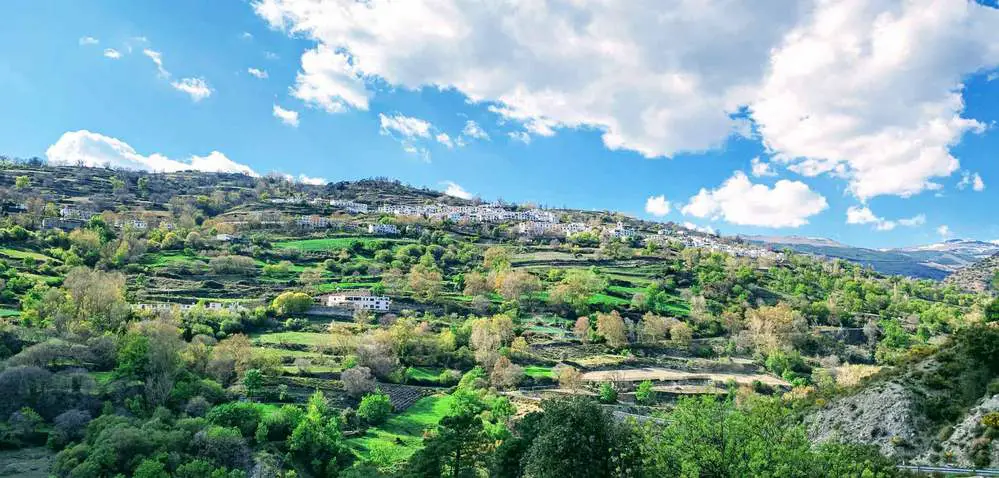Join us on a tour of the mysterious and timeless Alpujarra... an area of Spain where people have lived for many thousands of years...
Yet, as modern life has taken over in most places, these villages have retained their original charm, Moorish customs, and extraordinary beauty.
The Alpujarra region is a fairly large area that encompasses rolling hills, soaring mountains, and deep lush valleys. Its largest villages, at the foot of the Sierra Nevada Mountains, are just 45 km south of Granada and the region itself runs about 80 km from east to west.
Its highest peaks are the highest in mainland Spain and soar to 1,200 meters (4,000 ft) above sea level.
Being just 45 kilometers south of the city of Granada and having a fantastic highway system, the drive will only take you 45-minutes.
From the coastal village of Motril, you can also reach the Alpujarra villages in just under 35-minutes (33 km).
- From Granada: Driving south from Granada on the main N-323 highway towards the coast, look for the signs indicating "Las Alpujarras" and "Lanjarón" as you pass over the mountains. Exit the highway and head towards the left (east). Roads will be clearly marked.
- From Malaga & the Coast: take the N-340 highway east towards Almuñécar, Motril, and Almería. In about an hour after passing Almuñécar and when you reach Salobreña, take highway N-323 towards Granada. As you climb the mountains you will pass a dam and a lake on your left. Look for signs indicating "Las Alpujarras" and "Lanjarón". Exit the highway and head towards the right (east).
Who are we? An American expat with over 20 years of experience living and traveling in Spain, specifically in Malaga and
Granada. Darsey is a seasoned explorer of Andalucia. Drawing from decades of immersive experience, she offers deep insights
into this enchanting region of Spain, including off-the-beaten path destinations, the best places to stay, and the top bucket
list activities to try!
More...
Save money on your next trip with our favorite travel websites!
These villages can also be accessed very easily by bus.

 ** (1-2) Pretty corners of Capileira in the Alpujarras.
** (1-2) Pretty corners of Capileira in the Alpujarras.
Where you stay is going to depend on how long you plan to spend in the area. If you are planning on one or two nights, we suggest basing yourselves in either the
Lanjarón /
Orgiva area or in
Capileira which has the largest hotel selection in the
Poqueira Valley.
From either of these places, you could easily visit the other villages for the day, plus some hiking.
TOP RURAL HOTELS LAS ALPUJARRAS
The Alcadima Hotel - Lanjarón
- Located in the Andalusian spa town of Lanjarón, Hotel Alcadima offers impressive views over the Salao Valley. This
characteristic country house has indoor and outdoor pools and a sauna.
Read More...
Like we said above, the Alpujarras has more than 50 ancient villages scattered throughout the region, from the highest peaks of the Sierra
Nevada to the lushest valleys of the Costa Tropical, even extending to the Mediterranean Sea...
Our list of the BEST 10 villages of the Alpujarras starts at the foothills of the Sierra Nevada. The two towns of Lanjarón and
Órgiva are known as the 'gateway' villages and where your adventure begins.

 ** (1-2) Pretty corners of Bubión in the Alpujarras.
** (1-2) Pretty corners of Bubión in the Alpujarras.
From there, moving north we come across Soportújar, the town of witches, and then quickly on to the steep slopes of a lush river gorge, the "Barranco de Poqueira". There you will find the three most well-known Alpujarra villages, Pampaneira, Bubión, and Capileira.
Now, heading to the Sierra's highest peaks, we pass the small village of Pitres and then finally to the world-renowned village of "Jamón Serrano", Trevélez.
For those of you with extra time and an interest in seeing the further reaches of the Alpujarra, visit the two charming villages of Yegen and Bérchules.
The distance to the Alpujarras from either the city of Granada or the Costa Tropical is minimal - approximately 40 minutes. Thus hiking, walking, horseback riding, cycling or just exploring its Moorish villages can be enjoyed in a single day.
But, if you have longer, we highly recommend taking some time to explore more of the area and all of the beauty that it has to offer...

 ** (1-2) Pretty corners of Pampaneira in the Alpujarras.
** (1-2) Pretty corners of Pampaneira in the Alpujarras.
- Trip 1 (One-Day) - If you have one day start in the village of Pampaneira, it's the lowest of the "Poqueira Valley" villages, then slowly make your way up to Bubión, and end in Capileira.
If you have time, there is a great 3-hour hike that loops through the villages and the gorge with stunning views.
- Trip 2 (2-3-Days) - If you have 2-3 days, start by seeing Lanjarón and
Órgiva. You could also make a brief stop in Soportújar for lunch. From there continue with Trip 1.
If you enjoy hiking, there are two great hikes in Lanjarón you can add to the adventure.
- Trip 3 (4+ Days) - If you have three to four days, you can see so much more! Start with Trip 1 & 2, then continue on to Pitres and Trevélez. From there continue deep into the Alpujarra and stop off at Yegen and Bérchules.
If you're coming from Granada and haven't seen the Costa Tropical, it's one of the most beautiful coastal areas in Spain. Drive south until you hit the coast and visit Salobrena, Almunecar, and La Herradura.

Our first stop is at the foothills of the Sierra Nevada Mountains in a very attractive town that was once the favorite resting place for famed Spanish poet, Federico García Lorca... the village of Lanjarón.
With soaring Sycamore trees lining the streets, a lush forest with babbling brooks, overflowing fountains, and sumptuous hiking trails... Lanjaron is a delight for the visitor!
The town is also known for its ancient Moorish castle and stunning views, but especially for its therapeutic hot mineral springs and famous spa, the Balneario.
Lanjarón is considered to be the "gateway village" to the more northern Alpujarra regions, and whose unique culture still retains its strong roots to its ancient Morisco past.
The Nasrid Bridge (Tablate) - The Arab Castle - The Hondillo Neighborhood - The Balneario de Lanjaron (Spa) - The Water Museum - The Honey Museum
Located on the southern slopes of the Sierra Nevada National Park, you will find the largest and most important commercial town of the Alpujarra region, Órgiva.
Órgiva is an excellent base for exploring the beautiful Alpujarras. The countryside all around its fertile valley is just stunning. The expansive groves of orange and lemon trees, olives and pomegranates, bougainvillea, morning glory, and jasmine bring color and fragrance to this sunny land that is not to be missed.
Surrounded by mountains (Sierra Nevada, Sierra de Lújar, and La Contraviesa), Órgiva is a rural paradise.
One of the busiest and most popular villages in the Alpujarras in October... and also one of the scariest is Soportújar.
Legend has it that Soportújar once was the chosen village for local witches and wizards. As the fog rolled into this sleepy village, protecting it from prying eyes, the covens gathered here... in the dark of night... conducting their secret meetings and casting their mysterious spells. For this reason, the people of Soportújar to this day, are known as "Brujos" and "Brujas" (wizards and witches).
Being a typical Alpujarra village Soportújar also shares the same Moorish architecture as its neighbors. The name Soportújar means “Place of Arcades” which is a reference to the many covered walkways, called "tinaos", that were built to help support the town on such steep terrain.
 ** Beautiful Pampaneira streets and tinaos in Las Alpujarras.
** Beautiful Pampaneira streets and tinaos in Las Alpujarras.
Now we make our way ever higher into the Poqueira Gorge, over 1000 meters above sea level. Here you will find the MOST beautiful of the Alpujarra villages, starting with Pampaneira.
Pampaneira is the first of two villages on our tour that have been designated as one of the "Prettiest Villages in Spain"... as you tour its pretty streets and alleys you will soon understand why.
It's typical mountain characteristics include the whitewashed houses with flat roofs and chimney pots, usually smoking away on a cool day, the water channels that run through most of the streets in town, and the covered alleys or "tinaos" that are carefully adorned with beautiful overflowing pots of flowers.
Visiting Pampaneira should only take about 2 hours.
La Plaza de la Libertad - Iglesia de Santa Cruz - Craft Boutiques & Workshops - Chocolate Abuela ili (Homemade Chocolate Shop) - Fuente de San Antonio "La Chumpaneira" - Lavadero de Pampaneira
Now on to Bubión!
Bubión is the smallest of the Poqueira Gorge villages but equally as quaint and pretty. You can either drive up from Pampaneira or take the small footpath that leads up through the lush countryside. The walk will take you about 20 minutes but the scenery along the way is spectacular.
Once in Bubión take an hour or so winding through its winding streets and alleys and check out some of its 'top sites'. And, don't forget to browse some of the nice craft boutiques up by the main road.
Explore the picturesque streets and alleyways and then visit the Alpujarreña House-Museum - The Bubión Agricultural Museum - Iglesia de la Virgen del Rosario - Bubion's Main Plaza - Hondera Fountain & Laundry - Bubión Craft Shops - Loom Workshop
Now for the Alpujarra's second most beautiful village... Capileira! It's hard to believe that two of Spain's prettiest villages are just 5-minutes apart but la Alpujarra is a special place.
To get to Capileira you can either drive up or take the footpath from Bubion. This part of the trek is a little harder than the Pampaniera / Bubion section and it will take a little longer, about 45-minutes. Again the scenery of the soaring Sierra Nevada Mountains as a backdrop to the little village is worth the climb.
While in Capileira, check out the "top sites", explore its winding streets and alleys and pay attention to its special Moorish architecture.
Museo Etnológico, Iglesia de Santa María de la Cabeza, the main plaza with its boutiques and restaurants, the miradors, and the hikes.
Pitres is a tiny village nestled in the mountains just outside the Poqueira Gorge on the way up to the Alpujarra's highest peaks. It's much smaller than the other towns on our list and can easily be seen in just 30-minutes.
Although Pitres is not much of a tourist destination and doesn't have the amenities, shops, and restaurants that the others do, it's a good example of a typical Alpujarra village with its winding streets and alleyways, flat roofs, chimney pots, and an overabundance of brightly colored flowers.
Numerous hikes leave out of Pitres and pass through the region of La Taha which includes many smaller hamlets, the Bermejo River, bubbling irrigation canals, waterfalls, and bridges.
The Main Plaza & Iglesia de Nuestra Señora de la Expectación, Chocolates Sierra Nevada, Jardín de la Alpujarra, Fuente Agria, and El Chorrerón.
Now on to visit Trevélez... where you will get the chance to try the salty, sweet flavors of its world-class Jamón Serrano.
Located at the tip-top of the Sierra Nevada mountains and the doorway for travelers hiking towards Spain's highest peaks, Trevélez has become a mecca for those wanting to experience an authentic Alpujarra lifestyle without all the touristy commotion.
A visit to Trevélez will take you about 2 hours which should include a quick walk through the town's quaint streets and alleys and of course a fine Alpujarra meal while enjoying the spectacular views from Spain's highest village.
Take the self-guided tour through the village following the marked signs for the
"Ruta de Los Tres Barrios" and see the Fountains & Ancient Tinaos, the Parish Church of San Benito, the Secadero Museum of Jamones Vallejo, the Hermitage of San Antonio, and from the bridge leading out of town take a photo of the Rio Trevélez.
Home to the solitary British author for many years the far away village of Yegen is still a delight. Looking for a home, away from the hustle and bustle of city life, Gerald Brenan chose this tiny Alpujarra village for its quiet, its simplicity, and its beauty.
Brenan wrote his novel "South From Granada" while living and roaming these further reaches of the Alpujarra. His book details life, the way it once was... in a land and a time so remote...
As you reach the furthest lands of the Alpujarra, the villages become quieter and more at peace, life is slow here. The luxuries of the modern age are replaced with the bounty of nature and natural beauty.
Soaring Chestnut trees and fragrant orchards become the theme, rushing springs and fountains the details...
On the western slope of the Guadalfeo River, you will find two such places, Bérchules and Alcútar. With their houses perfectly adapted to the slope of the mountainside, an explosion of flowerpots on windows and balconies, flat roofs, and the characteristic tinaos, these villages exude the real and timeless Alpujarra.
The scent and vision of almond blossoms in the Spring, the blaze of wildflowers in early Summer, its varying altitudes, and all its natural
wonders make the Alpujarra an excellent getaway from Spain's busier cities and towns.
In all seasons of the year, La Alpujarra is a breathtaking
and invigorating place to see and stay in one of its quaint villages.
- During May and October, you are most likely to experience good weather in the Alpujarras with pleasant average temperatures that fall between
20 degrees Celsius (68°F) and 25 degrees Celsius (77°F).
- The hottest season is in June, July, August, and September.
- The Alpujarras has dry periods in June, July, August, and September.
- The warmest month is July with an average maximum temperature of 33°C (91°F).
- The coldest month is January with an average maximum temperature of 12°C (53°F).
- November is the wettest month. This month should be avoided if you are not a big fan of rain.
- July is the driest month.
Historically, La Alpujarra was colonized by many: Iberians, Celts, Romans, Visigoths, and Moors, and it was the final refuge for the Moors when the Catholic Kings reclaimed the land in the 15th Century.
At that time, the Spanish crown required that two Moorish families remained in every village to assist the new inhabitants - mainly those from Asturias, Galicia, and León - in learning how to work the land and irrigation systems on which they depended.
The Moorish influence is still evident today in its agricultural methods, architectural style, local dishes, carpet weaving methods, and names of different places... "Alpujarras" was derived from the Arabic word "Busherat", which translates to "land of herbs"... which can be seen and smelled everywhere.
The incredibly fragrant landscapes found here have captivated and inspired writers and painters alike since the 1800s. In recent years, alternative lifestyle thinkers, believers in ancient Asian religions, and numerous artisans and craftspeople have arrived and have chosen to make the Alpujarras their home.
Albondón - Albuñol - Castell de Ferro - Castillos de Baños - Gualchos - Lobras - Lújar - La Mamola - Melicena -
Polopos - Rubite - Sorvilán - Los Yesos
- Bérchules - Bubión - Capileira - Lanjarón - Órgiva - Pampaneira - Pitres - Soportújar - Trevélez - Yegens
Agustines - Alcázar - Alcútar - Alfornón - Almegíjar - Atalbeitar - Bargis - Las Barreras - Bayacas - Busquistar - Cádiar - Las Canteras - Las Cañadillas - Cañar - Carataunas - Los Carlos - Cástaras - Los Castillas - El Castillo de Huarea - Cherín - Cojáyar - Ferreirola - Fregenite - Fuente Victoria - El Golco - La Guapa - Haza del Trigo - Jorairatar - Júbar - Juviles - La Tahá - La Umbría/ La Solana - Laroles - Los Tablones - Mairena - Mecina Alfahar - Mecina Bombarón - Mecina Fondales - Mecina Tedel - Los Montoros - Las Moras - Murtas - Narila - Nechite - Nieles - Notáez - Olías - Picena - Pórtugos - El Pozuelo - Rambla del Banco - San Agustín - Tímar - Torvizcón - Turón - Ugíjar - Válor - Yátor
Adra - Alboloduy - Alcaudique - Alcolea - Alhabia - Alhama de Almería - Alicún - Almócita - Alsodux - Balanegra - Balerma - Bayarcal - Beires - Benecid - Benejí - Benínar - Bentarique - Berja - Canjáyar - Castala - Celín - Dalías - Darrícal - El Ejido - Eníx - Felíx - Fondón - Galachar - Guardias Viejas - Hirmes - Huécija - Íllar - Instinción - Laujar de Andarax - Lucainena - Las Norias - Ohanes - Padules - Pampanico - Paterna del Río - Puebla de Vícar - Rágol - Río Chico - San Roque - Santa Cruz de Marchena - Santa María del Águila - Terque - Vícar
